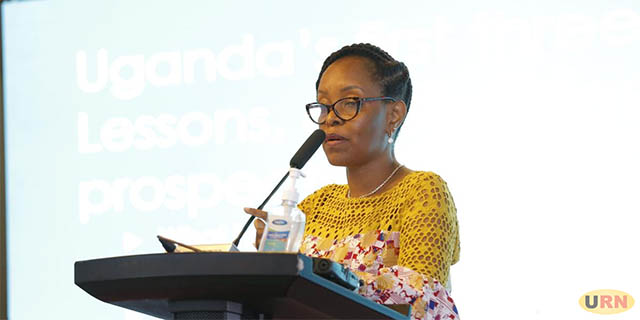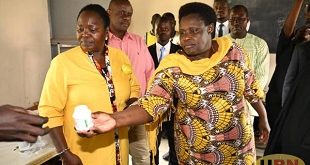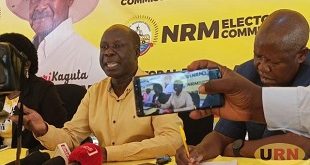
Kampala, Uganda | THE INDEPENDENT | The Uganda Extractive‘s Industries Transparency Initiative Secretariat (UGEITI Secretariat) has again raised a red flag about the discrepancies in the country’s gold import and exports.
UGEITI Secretariat hosted by the Ministry of Finance on Thursday release its report for Fiscal Year 2021/2022. Like in the previous reports, the variations between the figures of gold exports reported by Uganda Revenue Authority greatly vary with reports by the Department of Geological Surveys and Mines (DGSM)
According to the new report, there has also been unexplained jump in earnings from minerals. During the 2020/2021 report, UGEITI said production of minerals was worth 19 billion shillings. In the current report, it said production in minerals was worth 202 billion shillings.
“We want to understand what is driving the jump. We can see that the amount of gold production reported by DGSM is low compared to gold that was exported. So some interesting dynamics that we need to look at” said Mugambe
All gold exports from Uganda are supposed to be cleared by the Directorate of Geological Surveys and Mines(DGS) . DGSM has therefore insisted that Uganda Revenue Authority has the responsibility to report the source of the extra god exported during the reporting period.
That discrepancy has raised concerns about transparency with in government departments in the Mineral’s sector particularly on amount of gold being produced in country. UGEITI identified a number of gaps in the data currently available for the sector including estimates on the informal mining sector’s contribution. Some have suggested Uganda is a regional hub for illicit gold smuggled from elsewhere in East Africa, for onward export to gold trade hubs such as the United Arab Emirates (UAE). As a result of this gold smuggling, Uganda’s gold exports have grown exponentially since the 1990s and are now the highest in the region. The Uganda Revenue Authority (URA) recorded gold exports from refineries valued at UGX 6.3 billion, compared to imports reported by one refinery of just UGX 1.3 billion.
Meanwhile, the Directorate of Geological Survey and Mines (DGSM) reported gold production at only 15 kilograms, sparking questions about the origin of the excess exports.
“Accuracy of export data and a detailed analysis of the gold value chain remain key recommendations from the first and second EITI reports,” the latest EITI report, reviewing the 2021/2022 financial year, states
Gloria Kempaka Mugambe, the head of Secretariat at Uganda Extractive Industries Transparency Initiative (UGEITI) notes that the figures simply do not add up.
She added that either industry players are under reporting production or unregulated channels are facilitating the movement of minerals in and out of the country.
“Upon further investigation and discussions with the Uganda Revenue Authority (URA), we understand that some imports are not being accurately captured by their system. This issue seems to contribute to the gap observed in the data. This discrepancy is essential for a more accurate representation of gold trade statistics,” she said
According to the report, African Gold Refinery exported 2,421 kg of gold valued at 577.9 million shillings. Aurnish Trading LTM exported the largest amount, with 3,636 kg worth 757.7 million shillings. Bullion Refinery Limited shipped 11,080 kg, totaling 2.333 billion shillings, while Metal Testing and Smelting Co. Ltd exported 10,044 kg, valued at 1.907 billion shillings.
Simba Gold Refinery LTM exported 2,836 kg, worth 130.9 billion shillings. In an attempt to explain these discrepancies, some officials suggest that the reported gold may be entering the country through undocumented means, primarily from neighboring countries, particularly the Democratic Republic of Congo. However, artisanal miners have a different perspective.
Emmanuel kibirige, the National Coordinator of the Uganda Association of Artisanal and Small-Scale Miners argues that the gold in question is not illicitly sourced from other countries, as often believed. Instead, he explains, much of the gold is locally produced by artisanal miners.
“Given that the system has failed to adequately support artisanal miners, they continue to operate informally, without declaring their gold,” he said. “The gold is sold to buyers and eventually makes its way to refineries.”
Earnings from gold produced within the country should be used to improve the economic and social wellbeing of Ugandans.
David Sebagala, Senior Inspector of Mines at the Ministry of Energy, partly agrees with Kibirige, stating that much of the mineral production by Artisan miners remains largely undocumented.
“By nature, these artisanal miners prefer to operate in unconventional ways, even when it’s not necessary.” Artisanal and small-scale mining (ASGM) contributes to more than 90% of Uganda’s gold production. Many ASGM miners work with very small amounts of gold (less than 1 gram) and commonly use mercury for extraction.
Key districts involved in Artisan gold mining include Buhweju, Amudat, Moroto, Busia, Namayingo, Kassanda, and Kisoro.
This issue is not limited to gold alone. The discrepancy between mineral production and exports is also seen in other minerals like vermiculite and zinc, which are not reported as part of the country’s mineral production.
Another major problem in the sector is the continued export of unprocessed minerals despite a ban by President Museveni.
In 2015, the President instituted a ban on unprocessed minerals in an effort to promote local industries, encourage value addition, and create jobs for Ugandans. However, according to reports from the Uganda Revenue Authority (URA), many of the banned minerals have continued to be exported.
For example, vermiculite exports amounted to 12 billion shillings, and iron ore exports reached 919 million shillings. Other minerals, including zinc, kaolin, and tantalite, have also been exported. The main export destinations have been the USA, Spain, Kenya, the UK, Canada, and Belgium. Sebagala acknowledges the ban but mentions that sometimes investors are granted waivers. He is certain that this happened with vermiculite.
He explains that the discrepancy between production and exports of vermiculite could be due to stockpiles held by companies before the ban was enacted. When export permission is granted, these companies export their existing stockpiles, which may not have been recorded as production. “This explains the lack of production records for such minerals,” Sebagala notes, “as companies are exporting what they already had in stock.”
However, Sebagala emphasizes that for other minerals, beyond vermiculite, a proper explanation is needed to clarify how they left the country. “Someone in charge should be able to explain this,” he adds. Under the new mining law, Sebagala explains, no one is allowed to export any mineral without the knowledge of the Directorate of Geological Survey and Mines (DGSM).
Exporters must present an export permit to URA before clearance is given. “Going forward, we do not expect conflicting figures with URA, as the law requires an export permit issued by the DGSM. With this permit, we can track the tonnage and the specific minerals being exported. This means that banned minerals cannot be exported unless cleared,” he concludes.
The EITI international Board in May this year called on Uganda to reconcile gold the discrepancies in gold export and production.
The board said Uganda must publish estimates of informal mineral exports volumes and values, in order to fulfill the objective of providing a basis for addressing export related issues in the mining sector. It is recommended that the government entities comprehensively disclose and harmonise export data.
Uganda is also encouraged to describe the methods for calculating export volumes and values with a view to supporting improvements in the government’s oversight of mineral exports.
****
URN
 The Independent Uganda: You get the Truth we Pay the Price
The Independent Uganda: You get the Truth we Pay the Price



